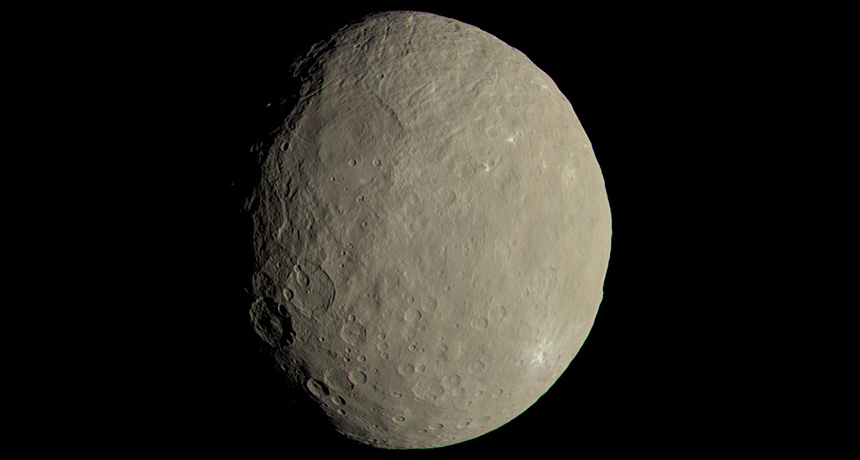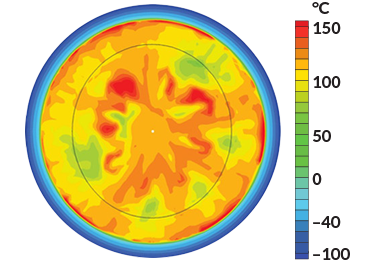Early solar system may have slung giant mud balls
The first asteroids may not have been so rocky, explaining some meteorite mysteries

Ceres is a dwarf planet in the asteroid belt. New research suggests it could have once been a ball of mud with a solid core.
IDA/DLR/MPS/UCLA/JPL-CALTECH/NASA
Asteroids are small clumps of rock orbiting the sun. But they likely weren’t always that way. Many may have started out as little more than mud. That’s the conclusion of a new analysis.
Most of what’s known about the first solid bodies in the solar system comes from meteorites. These are lumps of rock-and-metal from space that periodically collide with Earth. Researchers typically study a type of these meteorites known as carbonaceous chondrites (KAR-bon-AY-shus KON-dytes). Scientists have suspected these rocky chunks initially were part of asteroids.
Interestingly, their chemical recipe is almost the same as the sun’s. After removing all of the lightweight hydrogen and helium from the sun, you’d be left with heavier elements, such as carbon and sodium. And they’d exist in the same ratios seen in these bits of space rock. Some of these elements are radioactive. That means they are unstable, constantly shedding heat and some subatomic particles through a process known as radioactive decay.
The similarity between the recipe of the sun and these meteorites is key. It suggests the first asteroids evolved directly from the disk of gas and dust that existed just before the planets formed. That common recipe also suggests these rocks formed in the presence of water and at relatively low temperatures. How low? Around 150° Celsius (302° Fahrenheit).
It’s hard to explain all of these traits at once. The original asteroids may have been bigger than about 20 kilometers (12 miles) across. There’s no reason to think they weren’t. If so, then the decay of radioactive elements inside them would have made the rock hotter than 150 °C (302 °F).
Some planetary scientists have suggested that the asteroids were porous. That means they had lots of holes, somewhat resembling a sponge. Like a primitive plumbing system, water flowing through those holes would have cooled the rock. But that water also should have pulled some elements out of the rock. Afterward, the rock’s recipe no longer would be sunlike.
“It was a paradox,” notes Philip Bland. He is a planetary scientist at Curtin University of Technology in Perth, Australia.
Bland was running computer models on how those original globs of ice and dust could have compressed into solid rock. That’s when it hit him: What if they weren’t rock at all?
“At that moment, nothing has happened to force those grains together to turn it into a rock,” he says. This was just something everyone had assumed would occur.
Bland reasoned that before they had a chance to turn to rock, heat from radioactive decay in these globs of dust would have melted any ice. The resulting celestial body would then become an enormous glob of mud. And that mud could hold small rocky particles. Now the lumps wouldn’t be stripped of some elements. And these early asteroids could be any size — and relatively cool.
Making mudballs
Bryan Travis works at the Planetary Science Institute in Los Alamos, N.M. He and Bland used a computer to simulate how these mud balls would have evolved. And currents driven by convection would have played a role.
Convection currents form as a result of the rising and falling of material in a fluid or gas due to uneven temperatures. Such currents move liquid rock within Earth’s blisteringly hot mantle.
The team’s new simulations showed that these currents also would develop in many of the mud balls. The currents would help to transfer heat into space. After several million years, a ball would have hardened completely, yielding the asteroids seen today.
“It nails the paradox,” Bland says. He and Travis published this assessment July 14 in Science Advances.
The new model could solve several puzzles about the recipe of meteorites found on Earth. It also might explain why asteroids are different from comets, he says. Comets are more icy than rocky. They tend to hang out farther from the sun and may simply have formed later in the solar system’s history. If true, then there also would have been less radioactive heat available to melt them.

The new model also showed differences in the asteroids. Some would be muddy all the way through. Others would develop cores of larger grains, with a great mud ocean atop them.
That last scenario could explain not just asteroids but also bodies like the dwarf planet Ceres (SEER-eez). It is the largest object in the asteroid belt (a ring of rock that circles the sun between the orbits of Mars and Jupiter). Researchers recently studied Ceres with NASA’s Dawn spacecraft. It showed that Ceres has a rocky core.
Ceres may once have had an ocean that has since evaporated, says Edward Young. He is a planetary scientist at the University of California, Los Angeles, who was not involved in the new study. Evaporation on Ceres may have been something like what the team is describing for all early asteroids, he says.
Planetary scientist Brandon Johnson thinks the new model of mud-ball asteroids will inspire more research. Johnson works at Brown University in Providence, R.I. “I’m interested in it myself,” he says. “It makes a lot of sense and paints a clear picture of what might have been happening.”







